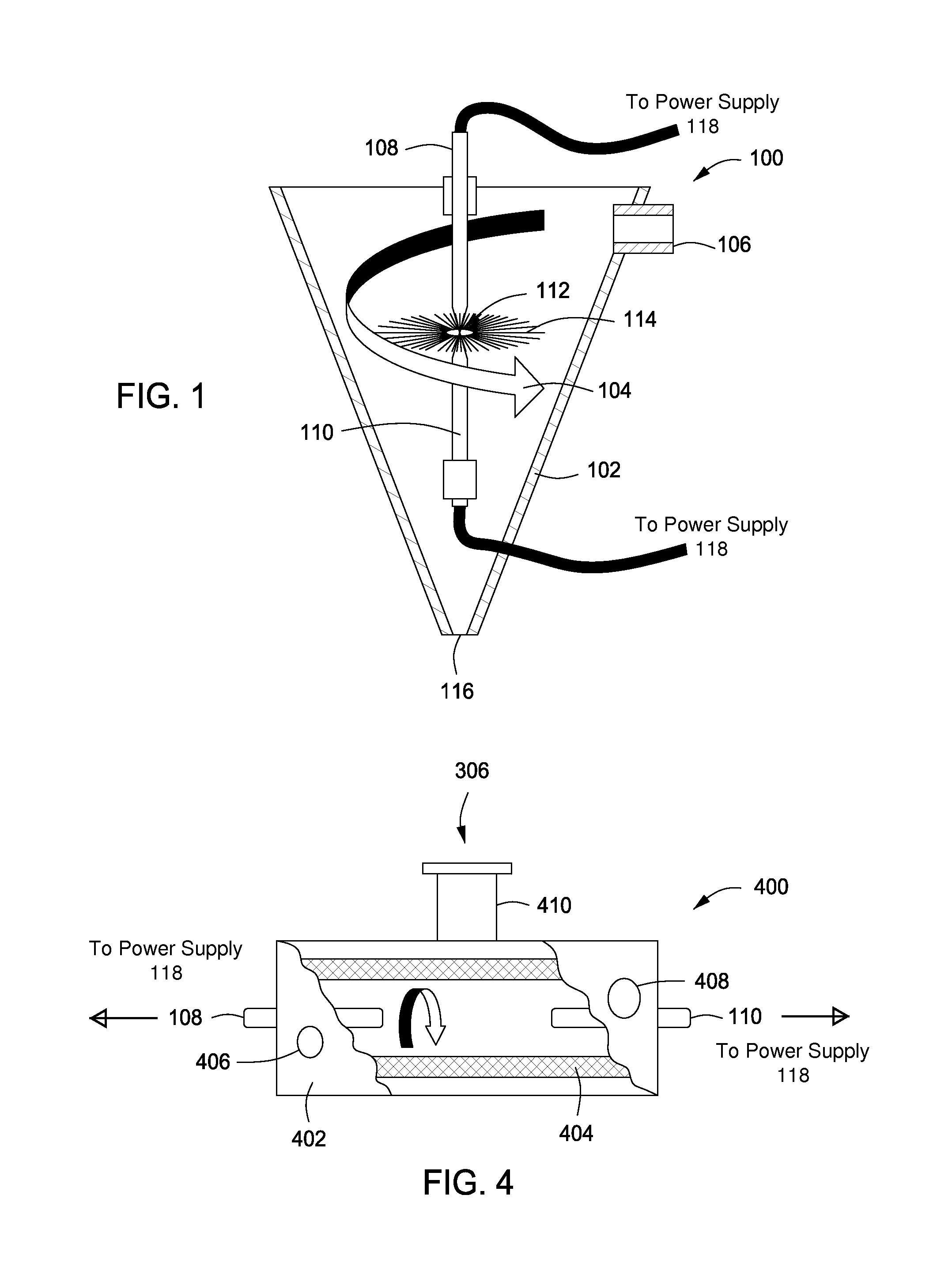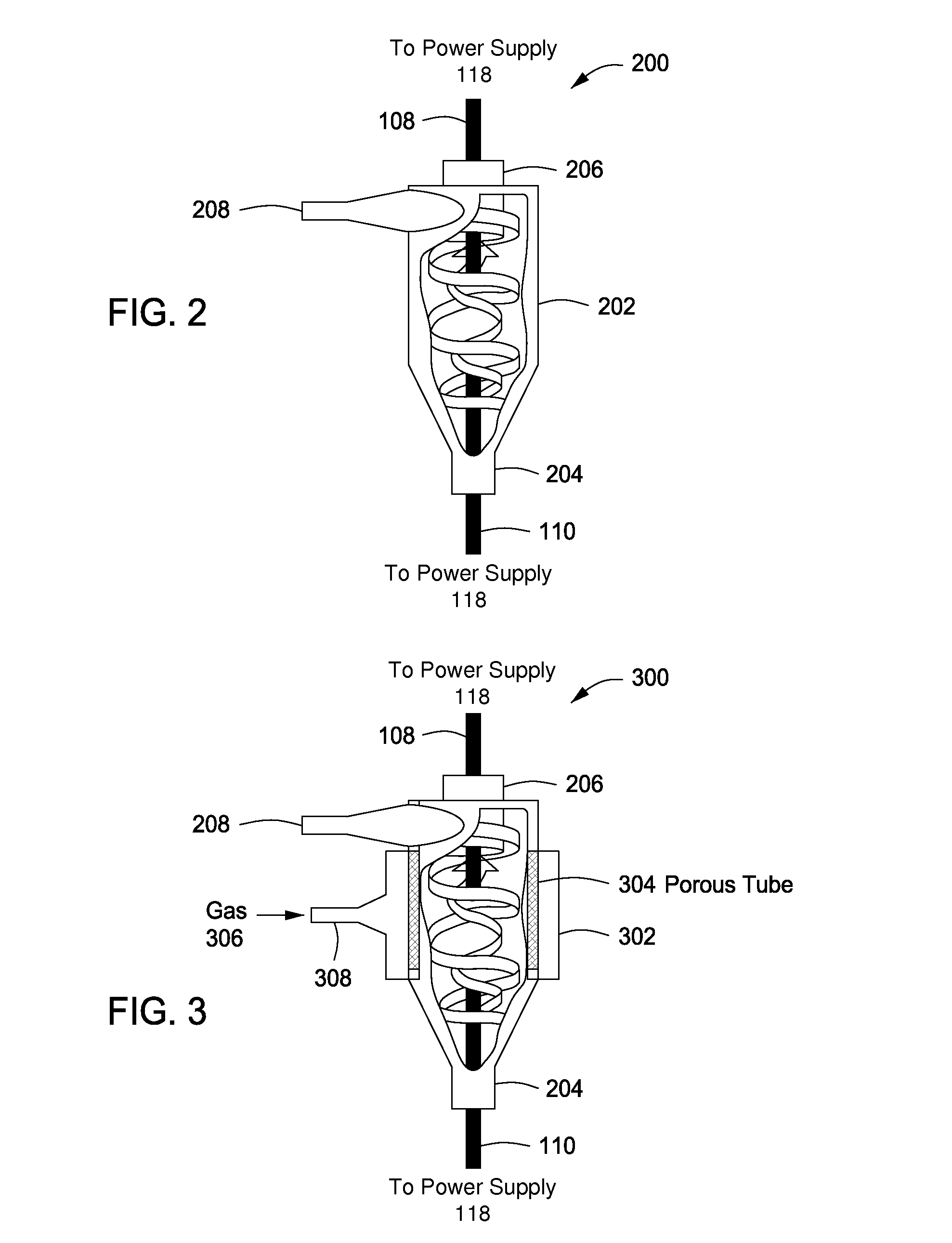System for treating a substance with wave energy from an electrical arc and a second source
a wave energy and wave energy technology, applied in the field of treating substances, can solve the problems of inefficiency of lamp, high radiation consumption of uv radiation system, and inability to maximize the use of electricity, and achieve the effects of reducing maintenance costs, reducing energy consumption, and reducing the number of uv radiation sources
- Summary
- Abstract
- Description
- Claims
- Application Information
AI Technical Summary
Benefits of technology
Problems solved by technology
Method used
Image
Examples
second embodiment
[0057]Now referring to FIG. 2, an Arc Whirl® cyclone separator 200 in accordance with the present invention is illustrated. A cyclone separator 202 can easily be modified for the present invention. The carbon rods 108 and 110 are inserted in the underflow 204 and overflow 206 of the cyclone separator 200. The substance is introduced into the cyclone separator 202 via inlet 208. The carbon arc is formed between the rods 108 and 110 within the core of the cyclone separator 202 when the carbon rods 108 and 110 are connected to power supply 118.
third embodiment
[0058]Referring now to FIG. 3, an Arc Whirl® gas-sparged hydrocyclone 300 in accordance with the present invention is illustrated. A hydrocyclone with a porous wall 304, referred to as an air-sparged hydrocyclone, can be used as the vessel 302 for the present invention. The carbon rods 108 and 110 are inserted in the underflow 204 and overflow 206 of the gas-sparged hydrocyclone 300. The substance is introduced into the vessel 302 via inlet 208. The carbon arc is formed between the rods 108 and 110 within the core of the vessel 302 when the rods 108 and 110 are connected to power supply 118. Air or gas 306 is introduced into the vessel 302 via gas inlet 308 connected to the porous wall 304. The air / gas sparged hydrocyclone 300 aids in stripping volatiles from the fluid and induce cavitation, in addition to the creation of a thin fluid film. Air-sparged hydrocyclones 300 can strip hydroscopic molecules, such as alcohols, from water. Further, the air boundary layer between the spargin...
fourth embodiment
[0062]Now referring to FIG. 4, an Arc Whirl® gas-sparged pipe with tangential flow 400 in accordance with the present invention is illustrated. A pipe 402 with porous wall 404 can also be used for the present invention. The carbon rods 108 and 110 are inserted in each end of the pipe 402. The substance is introduced into the pipe 402 via inlet 406 and allowed to exit via outlet 408. The carbon arc is formed between the rods 108 and 110 within the core of the vessel 402 when rods 108 and 110 are connected to power supply 118. Air or gas 306 is introduced into the vessel 402 via gas inlet 410.
PUM
| Property | Measurement | Unit |
|---|---|---|
| distance | aaaaa | aaaaa |
| distance | aaaaa | aaaaa |
| depth | aaaaa | aaaaa |
Abstract
Description
Claims
Application Information
 Login to View More
Login to View More - R&D
- Intellectual Property
- Life Sciences
- Materials
- Tech Scout
- Unparalleled Data Quality
- Higher Quality Content
- 60% Fewer Hallucinations
Browse by: Latest US Patents, China's latest patents, Technical Efficacy Thesaurus, Application Domain, Technology Topic, Popular Technical Reports.
© 2025 PatSnap. All rights reserved.Legal|Privacy policy|Modern Slavery Act Transparency Statement|Sitemap|About US| Contact US: help@patsnap.com



